Magnetic Recording Method (MRM) for Nondestructive Evaluation of Ferromagnetic Materials
Abstract
:1. Introduction
2. Materials and Methods
3. Results
4. Discussion
5. Conclusions
- The parameters (amplitude and frequency) of the quasi-sinusoidal pattern change significantly with the applied tensile stress, especially the amplitude in the elastic region and the frequency over the yield point.
- Regardless of the state, the load can be unequivocally determined based on formulated simple parameters.
- Additionally, the state after exceeding the yield point can be unequivocally determined based on changes in the amplitude of the signal and the frequency of the magnetization pattern.
- The obtained quasi-sinusoidal magnetization pattern is easy for later analysis.
- During the magnetization process, magnets can be placed at a relatively large distance (on the order of 1 mm) from the magnetized element.
- Further experiments are necessary to find the optimal and maximum distance between the magnets and the tested material.
- The proposed magnetization method can be used for flat surfaces.
- In the case of more complicated shapes of the tested element, it is necessary to make dedicated magnetizing systems.
- In order to obtain quasi-sinusoidal magnetization patterns on elements of larger sizes or to obtain a higher frequency of changes, it would be more effective to use a magnetizing head mounted on a motorized manipulator instead of magnets.
- The regularity of the magnetization pattern is not critical if the primary magnetization is measured and the signals are archived for normalization in later tests.
- While maintaining the signals measured after the magnetization process, the previous magnetization state of the sample is not important, but it is better to demagnetize the sample before magnetization to simplify the diagnostic process.
Author Contributions
Funding
Institutional Review Board Statement
Informed Consent Statement
Data Availability Statement
Conflicts of Interest
References
- Sam, M.A.I.M.N.; Jin, Z.; Oogane, M.; Ando, Y. Investigation of a Magnetic Tunnel Junction Based Sensor for the Detection of Defects in Reinforced Concrete at High Lift-Off. Sensors 2019, 19, 4718. [Google Scholar] [CrossRef] [Green Version]
- Shi, Y.; Zhang, C.; Li, R.; Cai, M.; Jia, G. Theory and Application of Magnetic Flux Leakage Pipeline Detection. Sensors 2015, 15, 31036–31055. [Google Scholar] [CrossRef] [PubMed]
- Ma, Q.; Tian, G.; Zeng, Y.; Li, R.; Song, H.; Wang, Z.; Gao, B.; Zeng, K. Pipeline In-Line Inspection Method, Instrumentation and Data Management. Sensors 2021, 21, 3862. [Google Scholar] [CrossRef] [PubMed]
- Wu, J.; Yang, Y.; Li, E.; Deng, Z.; Kang, Y.; Tang, C.; Sunny, A.I. A High-Sensitivity MFL Method for Tiny Cracks in Bearing Rings. IEEE Trans. Magn. 2018, 54, 1–8. [Google Scholar] [CrossRef]
- Qidwai, U.; Akbar, M.A.; Maqbool, M. Robotic MFL Probe Design for Inspection in Structural Health Monitoring System. In Proceedings of the 2018 8th IEEE International Conference on Control System, Computing and Engineering (ICCSCE), Penang, Malaysia, 23–25 November 2018; IEEE: New York, NY, USA, 2018; pp. 5–9. [Google Scholar]
- Tang, J.; Wang, R.; Liu, B.; Kang, Y. A novel magnetic flux leakage method based on the ferromagnetic lift-off layer with through groove. Sens. Actuators A Phys. 2021, 332, 113091. [Google Scholar] [CrossRef]
- Okolo, C.K.; Meydan, T. Axial Magnetic Field Sensing for Pulsed Magnetic Flux Leakage Hairline Crack Detec-tion and Quantification. In Proceedings of the 2017 IEEE SENSORS, Glasgow, UK, 29 October–1 November 2017; IEEE: New York, NY, USA, 2017; pp. 1–3. [Google Scholar]
- Wu, D.; Liu, Z.; Wang, X.; Su, L. Composite magnetic flux leakage detection method for pipelines using alternating magnetic field excitation. NDT E Int. 2017, 91, 148–155. [Google Scholar] [CrossRef]
- Zgútová, K.; Pitoňák, M. Attenuation of Barkhausen Noise Emission due to Variable Coating Thickness. Coatings 2021, 11, 263. [Google Scholar] [CrossRef]
- Rößler, M.; Putz, M.; Hochmuth, C.; Gentzen, J. In-process evaluation of the grinding process using a new Barkhausen noise method. Procedia CIRP 2021, 99, 202–207. [Google Scholar] [CrossRef]
- Hwang, Y.-I.; Kim, Y.-I.; Seo, D.-C.; Seo, M.-K.; Lee, W.-S.; Kwon, S.; Kim, K.-B. Experimental Consideration of Conditions for Measuring Residual Stresses of Rails Using Magnetic Barkhausen Noise Method. Materials 2021, 14, 5374. [Google Scholar] [CrossRef] [PubMed]
- Gaunkar, N.G.P.; Nlebedim, I.C.; Jiles, D.C.; Gaunkar, G.V.P. Examining the Correlation Between Microstructure and Barkhausen Noise Activity for Ferromagnetic Materials. IEEE Trans. Magn. 2015, 51, 1–4. [Google Scholar] [CrossRef]
- Novák, M.; Eichler, J. Magnetic Barkhausen Noise Spectral Emission of Grain Oriented Steel Under Ultra Low Frequency Magnetization. In Proceedings of the 2019 12th International Conference on Measurement, Smolenice, Slovakia, 27–29 May 2019; IEEE: New York, NY, USA; 2019; pp. 158–161. [Google Scholar]
- Sánchez, J.C.; De Campos, M.F.; Padovese, L. Comparison Between Different Experimental Set-Ups for Measuring the Magnetic Barkhausen Noise in a Deformed 1050 Steel. J. Nondestruct. Eval. 2017, 36, 66. [Google Scholar] [CrossRef]
- Vourna, P.; Ktena, A.; Tsakiridis, P.; Hristoforou, E. An accurate evaluation of the residual stress of welded electrical steels with magnetic Barkhausen noise. Measurement 2015, 71, 31–45. [Google Scholar] [CrossRef]
- Neslušan, M.; Trojan, K.; Haušild, P.; Minárik, P.; Mičietová, A.; Čapek, J. Monitoring of components made of duplex steel after turning as a function of flank wear by the use of Barkhausen noise emission. Mater. Charact. 2020, 169, 110587. [Google Scholar] [CrossRef]
- Santa-Aho, S.; Laitinen, A.; Sorsa, A.; Vippola, M. Barkhausen Noise Probes and Modelling: A Review. J. Nondestruct. Eval. 2019, 38, 94. [Google Scholar] [CrossRef] [Green Version]
- Dubov, A. A study of metal properties using the method of magnetic memory. Met. Sci. Heat Treat. 1997, 39, 401–405. [Google Scholar] [CrossRef]
- Shi, P.; Su, S.; Chen, Z. Overview of Researches on the Nondestructive Testing Method of Metal Magnetic Memory: Status and Challenges. J. Nondestruct. Eval. 2020, 39, 1–37. [Google Scholar] [CrossRef]
- Wang, H.; Dong, L.; Wang, H.; Ma, G.; Xu, B.; Zhao, Y. Effect of tensile stress on metal magnetic memory signals during on-line measurement in ferromagnetic steel. NDT E Int. 2021, 117, 102378. [Google Scholar] [CrossRef]
- Kolokolnikov, S.; Dubov, A.; Steklov, O. Assessment of welded joints stress–strain state inhomogeneity before and after post weld heat treatment based on the metal magnetic memory method. Weld. World 2016, 60, 665–672. [Google Scholar] [CrossRef]
- Shi, P.; Jin, K.; Zhang, P.; Xie, S.; Chen, Z.; Zheng, X. Quantitative Inversion of Stress and Crack in Ferromagnetic Materials Based on Metal Magnetic Memory Method. IEEE Trans. Magn. 2018, 54, 1–11. [Google Scholar] [CrossRef]
- Pang, C.; Zhou, J.; Zhao, R.; Ma, H.; Zhou, Y. Research on Internal Force Detection Method of Steel Bar in Elastic and Yielding Stage Based on Metal Magnetic Memory. Materials 2019, 12, 1167. [Google Scholar] [CrossRef] [Green Version]
- Chongchong, L.; Lihong, D.; Haidou, W.; Guolu, L.; Binshi, X. Metal magnetic memory technique used to predict the fatigue crack propagation behavior of 0.45%C steel. J. Magn. Magn. Mater. 2016, 405, 150–157. [Google Scholar] [CrossRef]
- Ren, S.; Ren, X.; Duan, Z.; Fu, Y. Studies on influences of initial magnetization state on metal magnetic memory signal. NDT E Int. 2019, 103, 77–83. [Google Scholar] [CrossRef]
- Li, Z.; Dixon, S.; Cawley, P.; Jarvis, R.; Nagy, P.B.; Cabeza, S. Experimental studies of the magneto-mechanical memory (MMM) technique using permanently installed magnetic sensor arrays. NDT E Int. 2017, 92, 136–148. [Google Scholar] [CrossRef] [Green Version]
- Macek, W. Fracture Areas Quantitative Investigating of Bending-Torsion Fatigued Low-Alloy High-Strength Steel. Metals 2021, 11, 1620. [Google Scholar] [CrossRef]
- Gao, W.; Wang, D.; Cheng, F.; Di, X.; Deng, C.; Xu, W. Microstructural and mechanical performance of underwater wet welded S355 steel. J. Mater. Process. Technol. 2016, 238, 333–340. [Google Scholar] [CrossRef]
- Corigliano, P.; Cucinotta, F.; Guglielmino, E.; Risitano, G.; Santonocito, D. Thermographic analysis during tensile tests and fatigue assessment of S355 steel. Procedia Struct. Integr. 2019, 18, 280–286. [Google Scholar] [CrossRef]
- Jacob, A.; Mehmanparast, A.; D’Urzo, R.; Kelleher, J. Experimental and numerical investigation of residual stress effects on fatigue crack growth behaviour of S355 steel weldments. Int. J. Fatigue 2019, 128, 105196. [Google Scholar] [CrossRef]
- Cadoni, E.; Forni, D.; Gieleta, R.; Kruszka, L. Tensile and compressive behaviour of S355 mild steel in a wide range of strain rates. Eur. Phys. J. Spéc. Top. 2018, 227, 29–43. [Google Scholar] [CrossRef]
- Rodrigues, D.; Leitão, C.; Balakrishnan, M.; Craveiro, H.; Santiago, A. Tensile properties of S355 butt welds after exposure to high temperatures. Constr. Build. Mater. 2021, 302, 124374. [Google Scholar] [CrossRef]
- Forni, D.; Chiaia, B.; Cadoni, E. High strain rate response of S355 at high temperatures. Mater. Des. 2016, 94, 467–478. [Google Scholar] [CrossRef]
- Xin, H.; Correia, J.A.; Veljkovic, M. Three-dimensional fatigue crack propagation simulation using extended finite element methods for steel grades S355 and S690 considering mean stress effects. Eng. Struct. 2021, 227, 111414. [Google Scholar] [CrossRef]
- Anglada, J.R.; Arpaia, P.; Buzio, M.; Pentella, M.; Petrone, C. Characterization of Magnetic Steels for the FCC-ee Magnet Prototypes. In Proceedings of the 2020 IEEE International Instrumentation and Measurement Technology Conference (I2MTC), Glasgow, UK, 25 May–28 June 2020; IEEE: New York, NY, USA, 2020; pp. 1–6. [Google Scholar]
- Chady, T.; Łukaszuk, R. Examining Ferromagnetic Materials Subjected to a Static Stress Load Using the Magnetic Method. Mater. 2021, 14, 3455. [Google Scholar] [CrossRef] [PubMed]
- Chady, T. Evaluation of Stress Loaded Steel Samples Using Selected Electromagnetic Methods. In Proceedings of the AIP Conference Proceedings, Green Bay, WI, USA, 27 July–1 August 2003; AIP Publishing: College Park, MD, USA, 2004; Volume 700, pp. 1296–1303. [Google Scholar]
- Chady, T. Evaluation of stress loaded steel samples using GMR magnetic field sensor. IEEE Sens. J. 2002, 2, 488–493. [Google Scholar] [CrossRef]
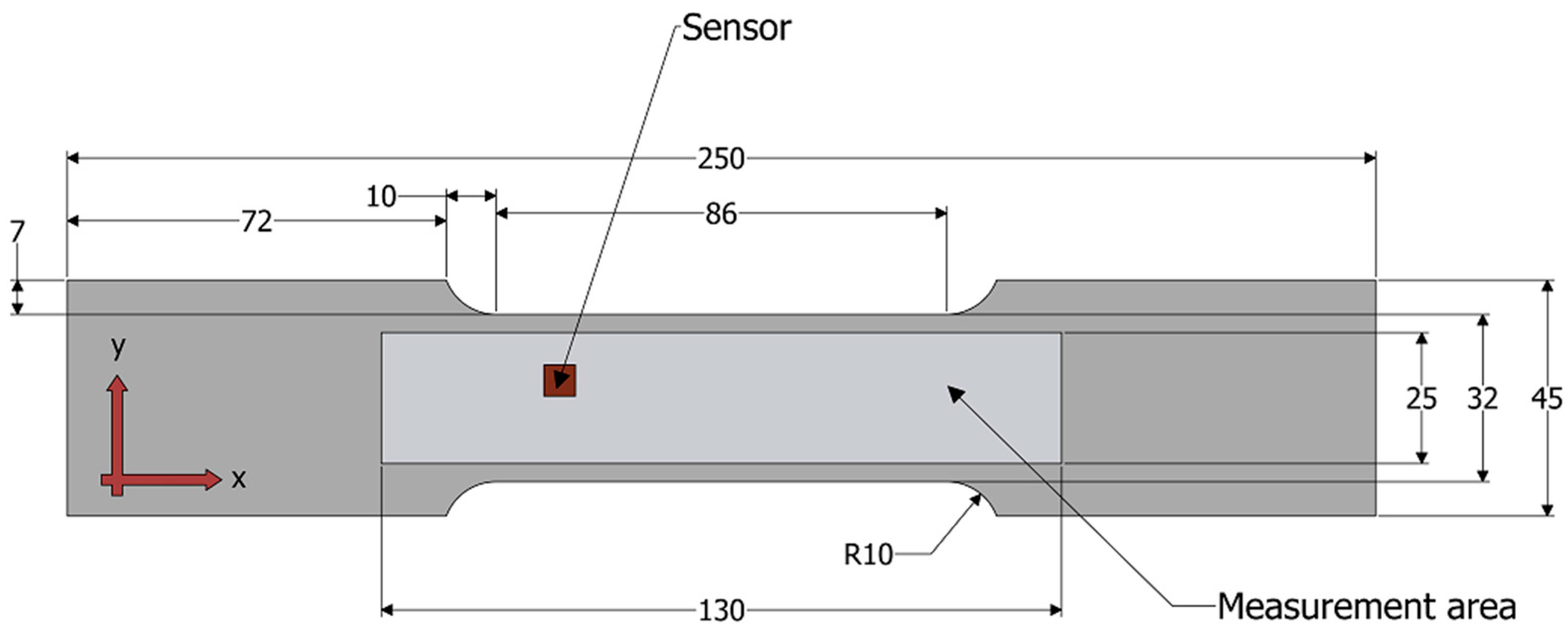
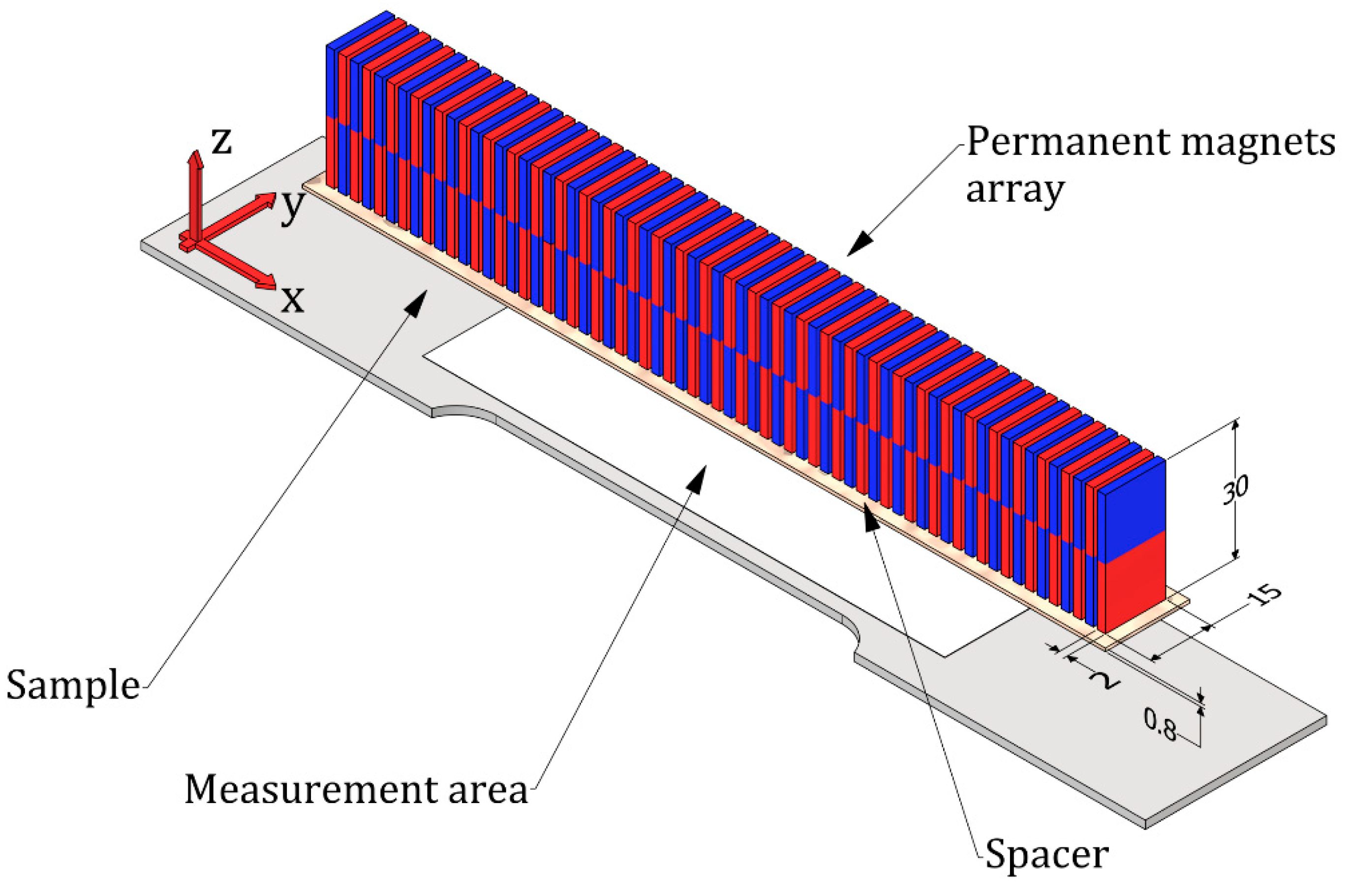



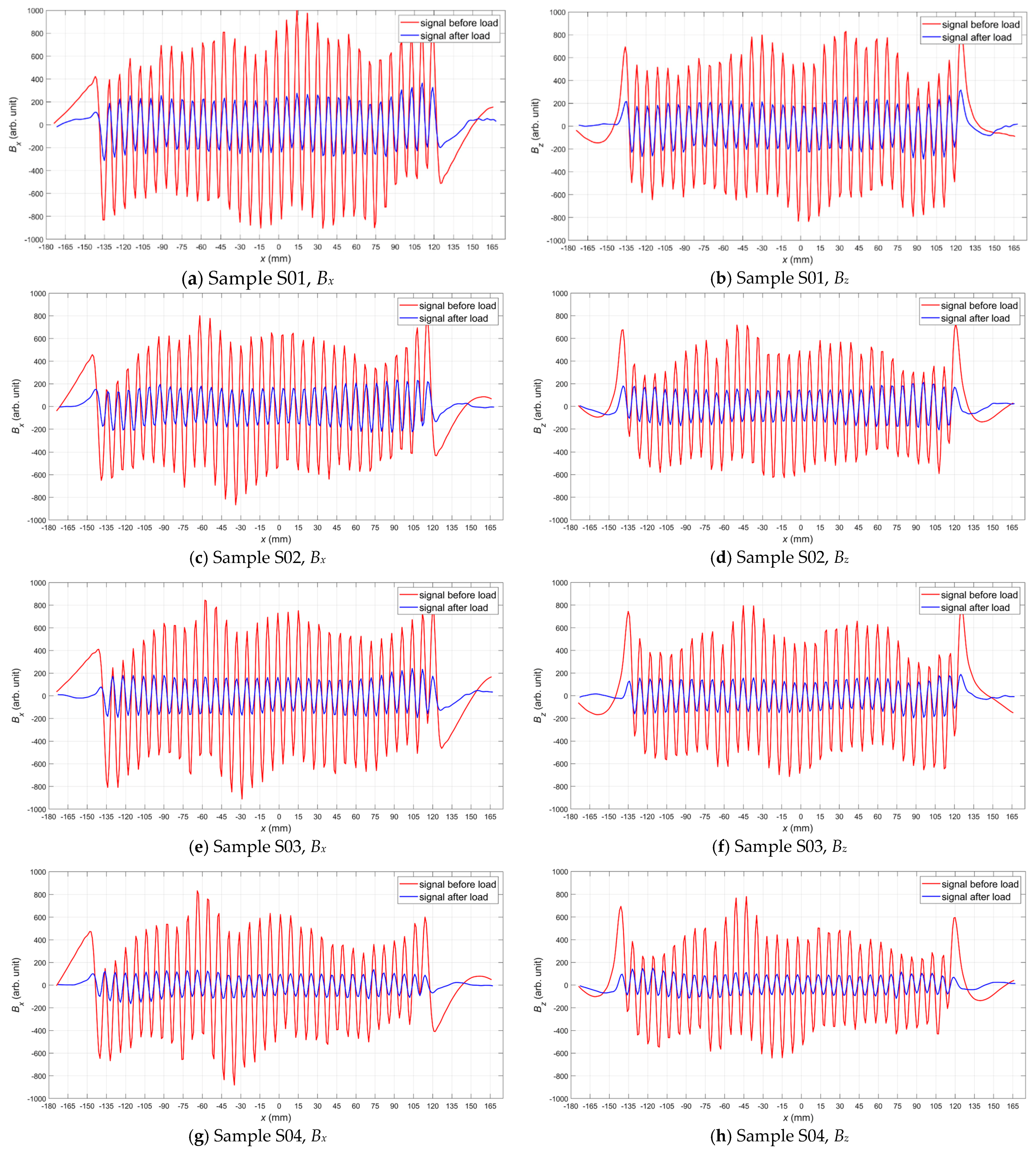

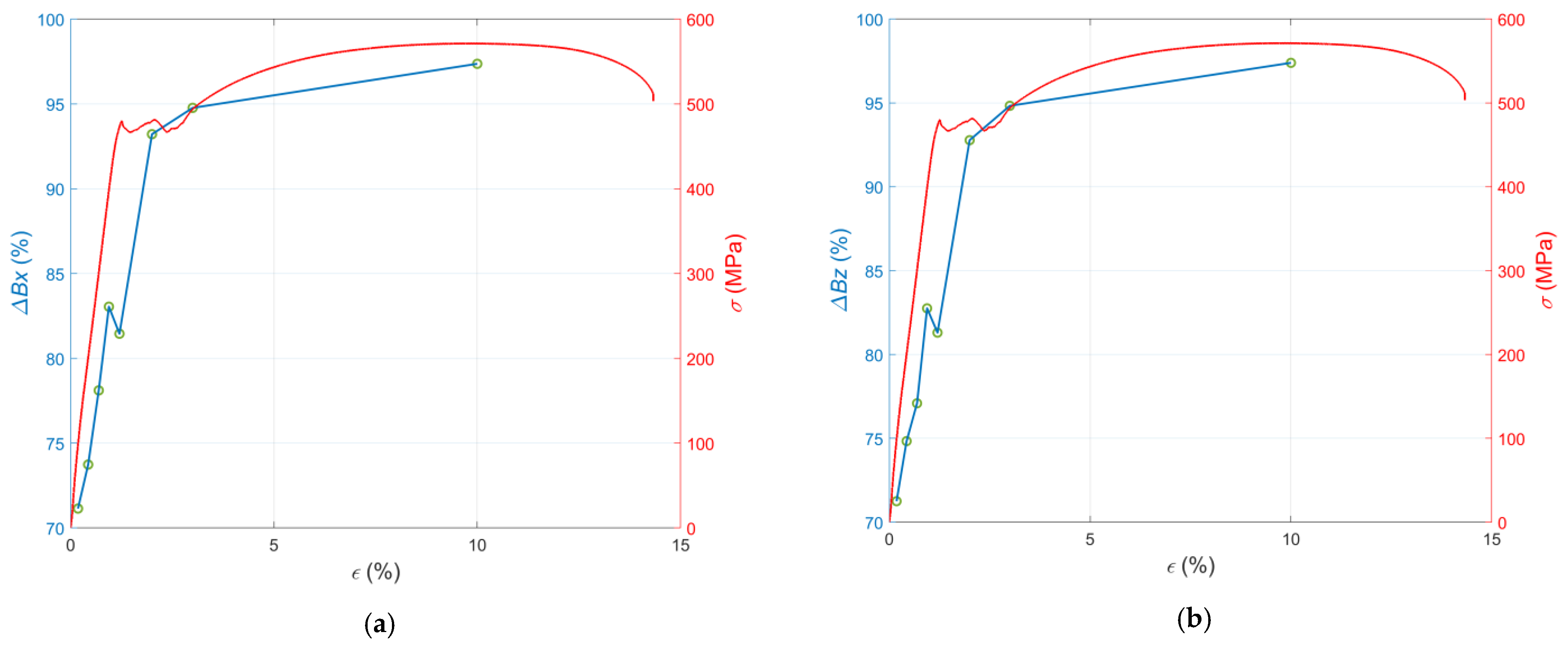

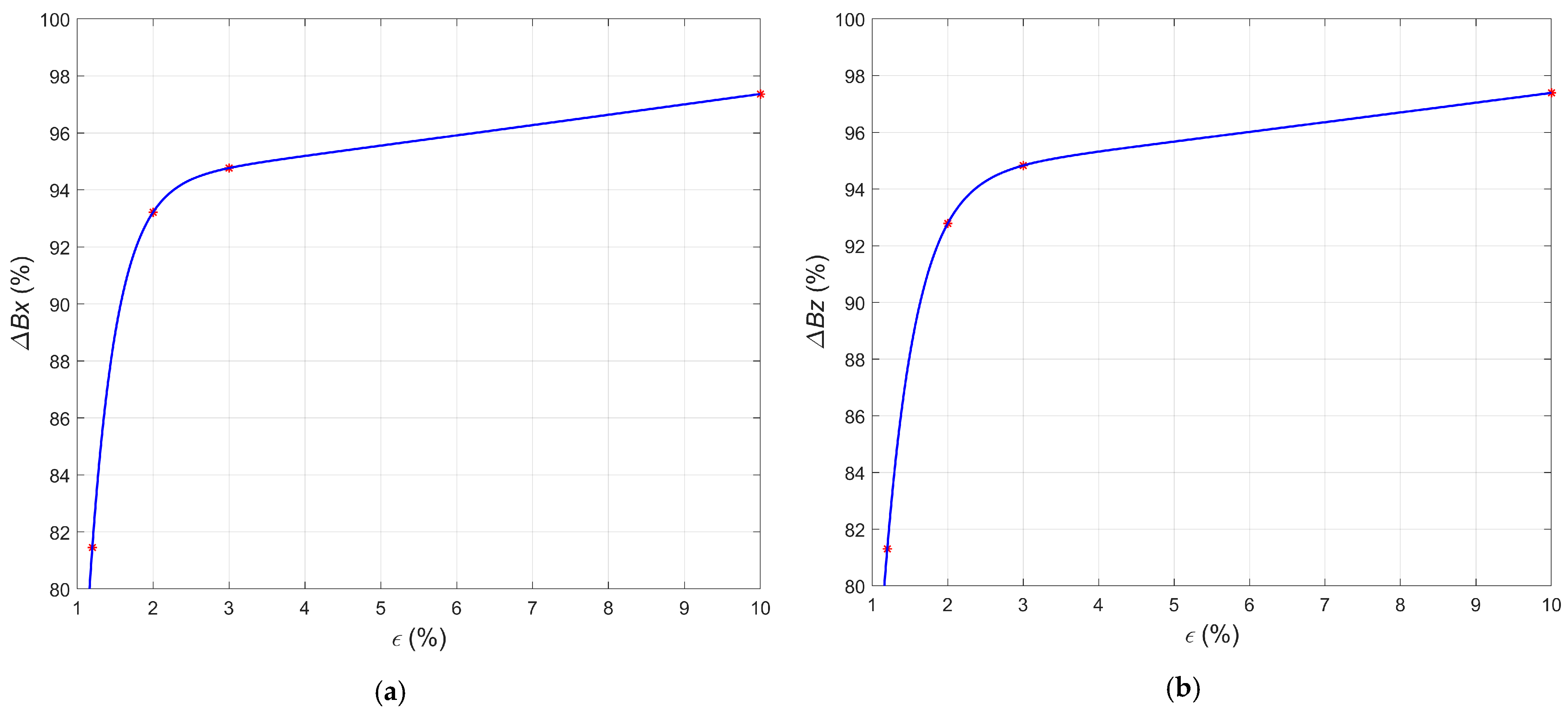
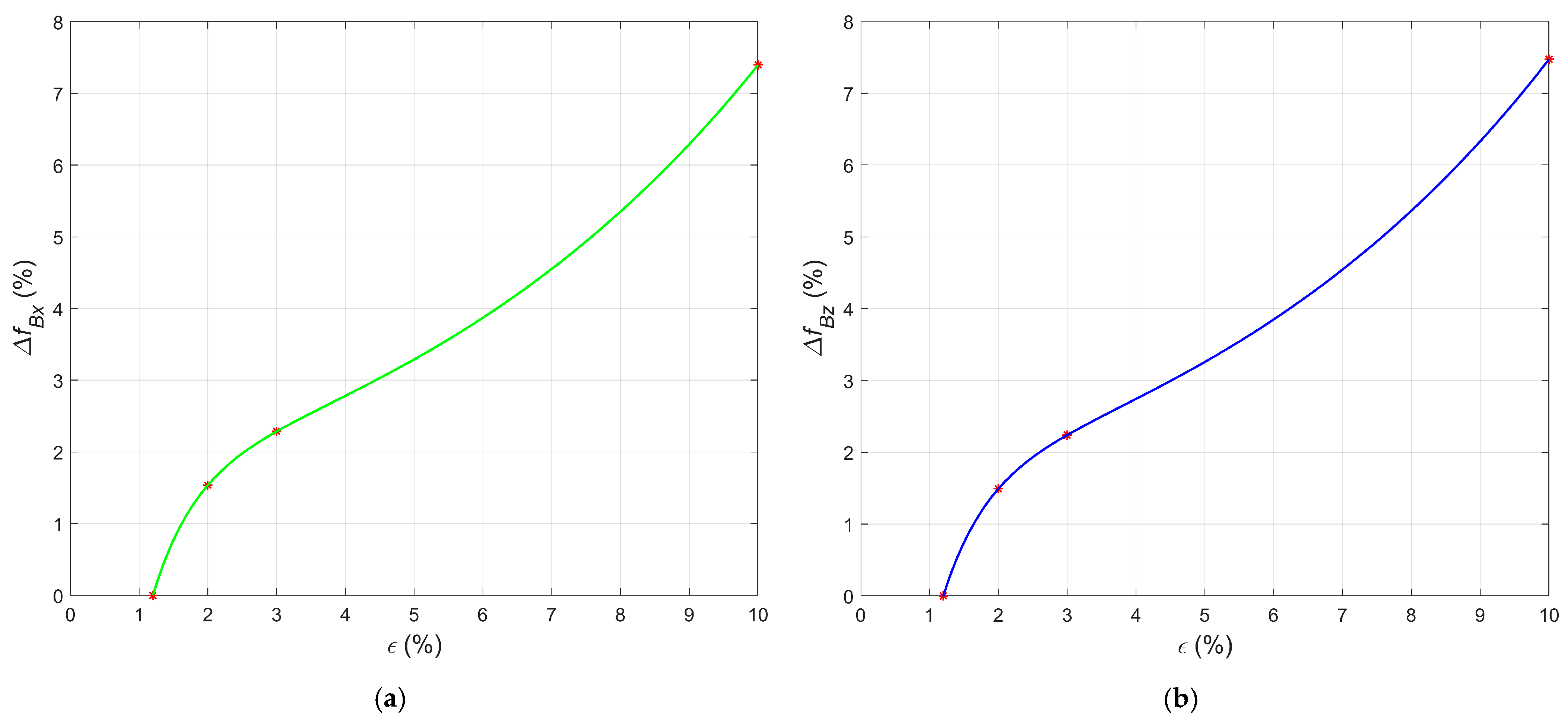
| Sample | Stress (MPa) | Strain (%) |
|---|---|---|
| S01 | 100 | 0.18 |
| S02 | 200 | 0.43 |
| S03 | 300 | 0.69 |
| S04 | 400 | 0.94 |
| S05 | 473 | 1.20 |
| S06 | 479 | 2.00 |
| S07 | 494 | 3.00 |
| S08 | 571 | 10.00 |
| Metal Magnetic Memory | Hysteresis Loop | Barkhausen Noise | Magnetic Flux Leakage | Magnetic Particle | Residual Magnetization | Eddy Current | Magnetic Recording | |
|---|---|---|---|---|---|---|---|---|
| Sensitivity to surface cracks | High | Low | Low | High | High | High | High | High |
| Sensitivity to subsurface cracks | High | Very Low | Very Low | Medium | Medium | Medium | High | High |
| Sensitivity to residual stress and plastic deformations(loading over the yield point) | High | High | High | Low | Very Low | High | High | High |
| Sensitivity to residual stress (loading below the yield point) | High | High | High | No | No | Medium | Low | High |
| Unambiguous identification of stress (loading below and over the yield point) | Medium | Medium | Low | No | No | Medium | Low | High |
| The necessity of preliminary preparation before operation | No | No | No | No | No | No | No | Magnetization of the pattern |
| The necessity of preliminary treatment before measurement | No | No | No | No | DC magnetization | DC magnetization | No | No |
| Influences of external DC fields during the measurement | Very High | Low | Low | Low | Medium | High | Very Low | Low/Medium |
| Influences of external AC fields during the measurements | Low | Low | High | Low | No | No | High | No |
| Influences of DC magnetization before the measurements | Very High | Low | Low | Low | Medium | Low | No | Low/Medium |
| Measurement speed | High | Low | Low | High | Medium | High | High | High |
| The complexity of the instrumentation | Low/Medium | High | High | Low | Very Low | Low | Medium | Low |
| Repeatability of the results | Low | Medium | Medium | High | High | High | Very High | High |
| Spatial resolution | High | Low/Very Low | Low/Very Low | High | Medium | High | Medium/High | High |
Publisher’s Note: MDPI stays neutral with regard to jurisdictional claims in published maps and institutional affiliations. |
© 2022 by the authors. Licensee MDPI, Basel, Switzerland. This article is an open access article distributed under the terms and conditions of the Creative Commons Attribution (CC BY) license (https://creativecommons.org/licenses/by/4.0/).
Share and Cite
Chady, T.; Łukaszuk, R.D.; Gorący, K.; Żwir, M.J. Magnetic Recording Method (MRM) for Nondestructive Evaluation of Ferromagnetic Materials. Materials 2022, 15, 630. https://doi.org/10.3390/ma15020630
Chady T, Łukaszuk RD, Gorący K, Żwir MJ. Magnetic Recording Method (MRM) for Nondestructive Evaluation of Ferromagnetic Materials. Materials. 2022; 15(2):630. https://doi.org/10.3390/ma15020630
Chicago/Turabian StyleChady, Tomasz, Ryszard D. Łukaszuk, Krzysztof Gorący, and Marek J. Żwir. 2022. "Magnetic Recording Method (MRM) for Nondestructive Evaluation of Ferromagnetic Materials" Materials 15, no. 2: 630. https://doi.org/10.3390/ma15020630
APA StyleChady, T., Łukaszuk, R. D., Gorący, K., & Żwir, M. J. (2022). Magnetic Recording Method (MRM) for Nondestructive Evaluation of Ferromagnetic Materials. Materials, 15(2), 630. https://doi.org/10.3390/ma15020630







